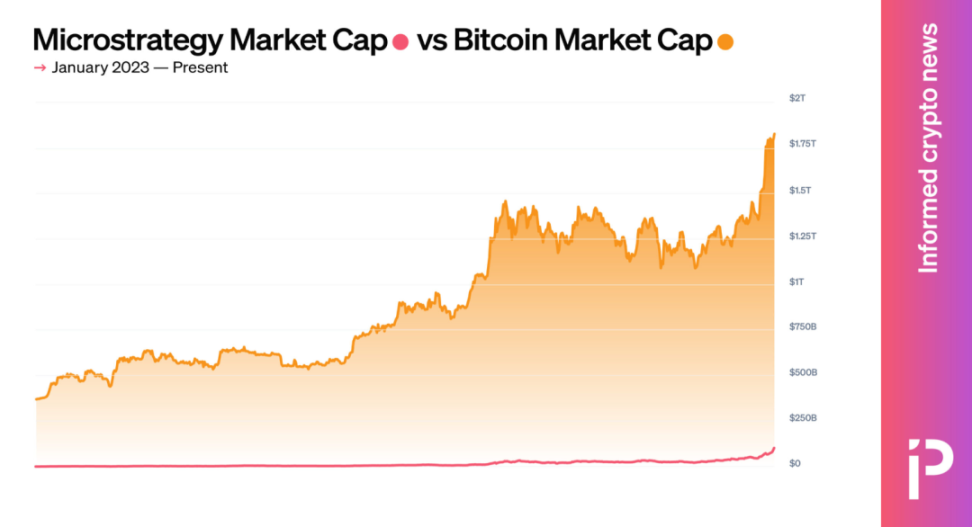MicroStrategy has almost recklessly pushed Bitcoin to the center of traditional capital markets. Through a combination of equity dilution and zero-interest bonds, the company has boldly ventured into the capital markets, fully betting on the long-term value of Bitcoin. But is this model a high-stakes gamble or a forward-looking vision of future asset dynamics?
Written by: AY FundInsight

In 2023, the story of MicroStrategy resembles a capital maze adventure in the financial markets, filled with risks and ambitious calculations. Its market value has soared from $1.8 billion at the beginning of the year to the current $111 billion, and the driving forces and logical chains behind this are intriguing. As a company with Bitcoin as its core strategy, MicroStrategy's actions not only serve as a bridge between traditional financial means and the cryptocurrency market but also have profound implications for the future of the web3 industry. Aiying FundInsight will delve into MicroStrategy's strategic logic in Bitcoin-driven growth, capital leverage, and governance transformation, as well as the insights this provides for the entire web3 financial ecosystem.
I. Bitcoin-Driven: From Marginal Asset to Core Strategy
MicroStrategy's growth path is undoubtedly inseparable from its aggressive positioning in Bitcoin. At the beginning of 2023, the company's market value was far below the value of its Bitcoin holdings, but through large-scale financing and a series of high-risk capital operations, its market value is now 3.55 times its Bitcoin holdings, equivalent to 5.9% of Bitcoin's market value.

Michael Saylor views Bitcoin as digital gold that transcends traditional currency, and based on this, he has constructed the core logic of the company's growth. In the context of web3, MicroStrategy represents a new type of enterprise that uses digital assets as a foundational support, attempting to leverage the long-term appreciation expectations of Bitcoin to instill confidence in traditional capital markets about the future. As Bitcoin prices rise, MicroStrategy's market value has also increased, with the capital market placing high trust in its Bitcoin-driven premium.
However, the market's attitude towards this "digital gold standard" strategy is not entirely uniform. While some investors are confident about MicroStrategy's future, with some believing its market value could surpass Bitcoin itself, this idea is not universally accepted by all rational investors. The decentralized spirit of web3 and the volatility of Bitcoin make such speculation fraught with uncertainty, as market confidence is not static.
II. Leveraged Capital Operations: An Innovative Combination of Dilution and Zero-Interest Bonds
MicroStrategy's success lies not only in its choice of Bitcoin as a cutting-edge asset but also in how it cleverly utilizes traditional capital market tools to obtain unprecedented capital leverage.
1. Equity Dilution: The Strategy of Value Dilution
Aiying FundInsight observes that MicroStrategy's financing methods mainly fall into two categories: equity dilution and zero-interest bonds.
(1) The Process and Logic of Equity Dilution
- MicroStrategy raises funds through issuing additional shares, with almost all proceeds used to purchase Bitcoin.
- This approach creates a unique "value dilution" logic, where although the company dilutes the rights of existing shareholders, the appreciation expectations of Bitcoin lead the market to interpret this dilution as an increase in asset value, thereby driving up the company's stock price.
- Aligning Shareholder Interests: After each stock issuance, the company immediately invests the funds into Bitcoin purchases, creating an immediate reinvestment of funds that tightly links shareholder interests with the long-term appreciation of Bitcoin. This ripple effect in the financial market continuously enhances investor confidence in the company's future. Many investors even view this as an indirect way to hold Bitcoin and are willing to pay a premium for this asset allocation model.
2. Zero-Interest Convertible Bonds: The Game of Capital Returns
(1) The Strategy of Issuing Zero-Interest Convertible Bonds:
- Another financing method for MicroStrategy is through zero-interest bonds. In a recent round of financing, MicroStrategy expanded the bond size from $175 million to $2.6 billion, with a zero coupon.
- Returns Depend on Stock Price Growth: Holders of these bonds do not receive traditional interest income; instead, their returns are closely tied to the future growth of MSTR's stock price. They can be converted into MicroStrategy's common stock at a future date, meaning that investors' ultimate returns depend entirely on the rise in MicroStrategy's stock price, somewhat akin to employee stock options, which are directly related to the value of the Bitcoin held by the company.
(2) High-Risk Betting by Investors:
- Investors take on high-risk bets. They choose to forgo regular interest income in favor of faith in MicroStrategy's future growth—especially its close ties to Bitcoin.
- The Nature of Long-Term Call Options: These bonds essentially function as a long-term call option, where investors can only profit if MicroStrategy's stock price rises significantly. This potential source of returns primarily relies on Bitcoin's price movements and the market's confidence in MicroStrategy's governance capabilities.
(3) The Chain Reaction in Capital Markets:
- This financing method is not just about capital input; it resembles a game with future markets. This game triggers a massive chain reaction, where each link drives overall growth, filled with a delicate balance between high risk and high return.
- The Synergistic Effect with Equity Dilution: MicroStrategy's bond financing strategy complements its equity dilution, forming a unique capital operation model. This model resonates in the financial markets, with market confidence in the company's future continuously driving capital inflows, and the core of this game is a firm belief in Bitcoin and an optimistic outlook on the future of the digital asset world.
III. Governance Transformation: From Saylor's Control to Institutional Governance
Alongside capital expansion, MicroStrategy's governance structure has also undergone significant changes. Michael Saylor's fall from absolute control of voting rights marks the company's transition from a "controlled company" to a more market-oriented and institutional governance model.
In the past, Saylor had the final say in company decisions through his control of Class B common stock, and MicroStrategy was thus classified as a "controlled company" by NASDAQ. However, with the large issuance of Class A common stock, the voting advantage of Class B shares has been diluted, and Saylor's voting power has fallen below 50%. The company has thus been forced to establish an independent nomination committee, and board decisions have begun to shift towards a more collective approach. This change not only means the company needs to respond more transparently to market oversight but may also bring more uncertainty to its future strategic decisions.
In the web3 ecosystem, the transformation of governance structures often represents a company's transition from the aggressive growth phase of a startup to a more stable and sustainable development period. The case of MicroStrategy reflects the typical characteristics of this transformation: rapid expansion under personal leadership and gradual normalization under institutional governance. For the web3 industry, which pursues decentralization, this shift is also an inevitable trend of internal power checks and balances.
IV. Deep Reflections from Aiying FundInsight
MicroStrategy's capital operation path has sparked deep reflections from Aiying FundInsight. Can such a strategy be sustained, or how will it change the entire web3 financial ecosystem? Under Michael Saylor's leadership, MicroStrategy has almost recklessly pushed Bitcoin to the center of traditional capital markets. Through a combination of equity dilution and zero-interest bonds, the company has boldly ventured into the capital markets, fully betting on the long-term value of Bitcoin. But is this model a high-stakes gamble or a forward-looking vision of future asset dynamics?
From a deeper perspective, MicroStrategy has transformed itself into a structured tool for indirectly holding Bitcoin by leveraging the faith of shareholders and bondholders in Bitcoin. **It relies not only on the market's perception of Bitcoin but also on linking traditional financing tools with digital assets, paving a new path in the financial realm. However, this path is fraught with risks and uncertainties, especially in the face of Bitcoin's price volatility, where *the leverage risks faced by MicroStrategy will be dramatically amplified.*
What is even more thought-provoking is the demonstrative effect of this capital operation method on the overall web3 industry. Many companies may be inspired to emulate MicroStrategy by structuring their holdings and financing around crypto assets as primary assets. However, without hedging mechanisms and diversified risk management, such strategies are likely to bring systemic market risks. While MicroStrategy's debt and equity dilution methods may seem successful, the underlying logic is based on the premise of Bitcoin's continuous price increase. Once this premise falters, the entire foundation of financing and growth will also be impacted.
Aiying FundInsight believes that the case of MicroStrategy is both a profound experiment in new capital operations and a high-risk market gamble. It demonstrates how web3 companies can utilize traditional financial markets to expand their digital asset holdings, but it also reveals the significant risks inherent in such strategies. If the market ecology of crypto assets can continue to optimize in the future, then MicroStrategy may become a pioneer of a new corporate model; but if market sentiment reverses, such high-leverage operations could become a significant risk point. Aiying FundInsight will analyze MicroStrategy's debt structure and potential risks in the next issue, so stay tuned.
免责声明:本文章仅代表作者个人观点,不代表本平台的立场和观点。本文章仅供信息分享,不构成对任何人的任何投资建议。用户与作者之间的任何争议,与本平台无关。如网页中刊载的文章或图片涉及侵权,请提供相关的权利证明和身份证明发送邮件到support@aicoin.com,本平台相关工作人员将会进行核查。



